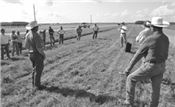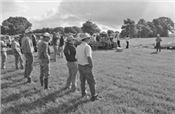|
Possible New Rice Varieties Subject Of Field Days
LAKE ARTHUR, LA.
One or two breeding lines of rice will be chosen this year for seed increases that could result in the first variety release for new rice technology called Provisia.
At field days in Vermilion Parish on Tuesday and in Jefferson Davis Parish on Wednesday, LSU AgCenter rice breeder Steve Linscombe said whatever is selected will undergo a seed increase in Puerto Rico this winter for a possible release in 2017. “The good news is by 2018, we should have plenty of seed available.”
He said Provisia will provide farmers with an alternative technology to fight red rice, extending the viability of Clearfield rice, which has allowed farmers to control red rice.
The first Clearfield variety was released in 2002, but outcrosses of red rice with the Clearfield trait have been causing farmers problems in recent years, and Provisia is expected to control those problems.
The new technology discovered by BASF has been in development for the past four years.
Linscombe also said he will identify one or two lines of Clearfield Jazzman this year for seed increases in Puerto Rico this winter, and a new variety could be chosen next year.
AgCenter weed scientist Eric Webster told farmers that Provisia can be rotated with soybeans and Clearfield rice to control outcrosses and weedy rice.
He also said a new Dow product, Voyant, is being tested for rice with good potential as a broad spectrum herbicide that can control broadleaf weeds, aquatic plants as well as grasses.
He said flatsedge is showing resistance to Permit herbicide, but the weed can be controlled with Facet, Prowl and Sharpen.
AgCenter plant pathologist Don Groth said many farmers planted earlier than usual this year, and that should result in less disease pressure.
He said cutbacks in fertilizer could mean reduced disease outbreaks. “The more nitrogen you have, the more diseases.”
He said blast and sheath blight disease has been light this year.
Groth warned farmers that Cercospora disease is becoming resistant to propiconazole fungicide. A rate of 6 ounces per acre provided good control at one time, but now 9-12 ounces are needed. Sercadis is a good alternative chemical, he said.
AgCenter rice specialist Dustin Harrell said recently planted rice in north Louisiana is just starting to emerge, while fields that were planted in south Louisiana in March are near the grain heading stage.
He said almost one-third of south Louisiana rice was planted by March 10, while north Louisiana farmers had to wait for floodwaters to recede to plant their crop in the past few weeks.
Harrell said fields that were not treated with the bird repellent AV-1011 had to be replanted. A stand of rice next to the research plots at the Kent Lounsberry farm near Lake Arthur was not treated with the bird repellent, and it was decimated by foraging birds.
AgCenter rice breeder Adam Famoso told farmers about new equipment at the Rice Research Station that will allow screening of thousands of lines of rice for genetic traits related to disease resistance and grain quality. But he said the equipment will not replace field testing of rice lines.
At the Vermilion Parish Field Day, AgCenter economist Michael Deliberto said increased rice acreage this year means low prices will continue for 2016.
He said that more than 3 million acres were expected to be planted this year, a 17 percent increase over the 2015 total. The acreage in the largest rice-growing state, Arkansas, has been estimated at more than 1.6 million acres, he said.
With good yields on the increased acreage, he said, abundant rice supplies will keep prices suppressed.
But he said long-grain exports have been on the increase to Latin American countries, including Mexico, the largest U.S. rice customer.
Linscombe said checkoff funds paid by farmers result in research to help grow better crops. “Those funds certainly give us much more stability in trying to come up with new techniques for your operations.”
He also thanked farmers Kent Lounsberry near Lake Arthur and Jimmy Hoppe near Fenton, for providing land to conduct off-station research. The Lounsberry farm has hosted the work for 32 years, and the Hoppe farm has made a research field available for 20 years. ∆

LSU AgCenter economist Mike Deliberto talks at the Vermilion Parish Rice
Field Day about the economic outlook for rice.

LSU AgCenter rice breeder Adam Famoso, at left, talks at the Vermilion Parish
Rice Field Day about new lab equipment to analyze genetic markers for traits
related to disease resistance and quality.

LSU AgCenter rice breeder Steve Linscombe, far right, talks at the
Southwest Rice Field Day in Jefferson Davis Parish.

LSU AgCenter plant pathologist Don Groth talks at field day near
Fenton in Jefferson Davis Parish.
|
|